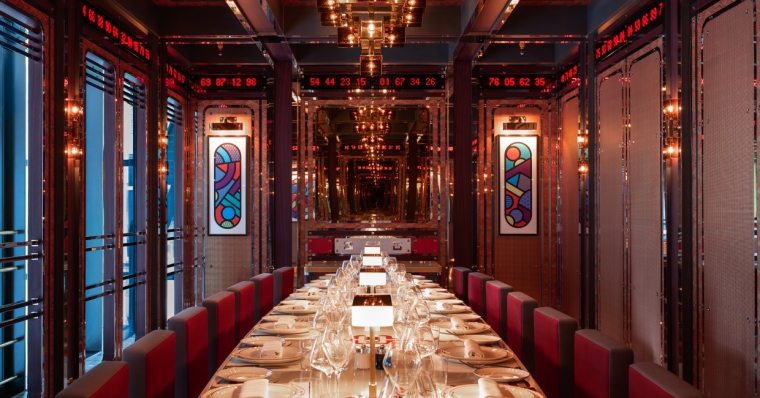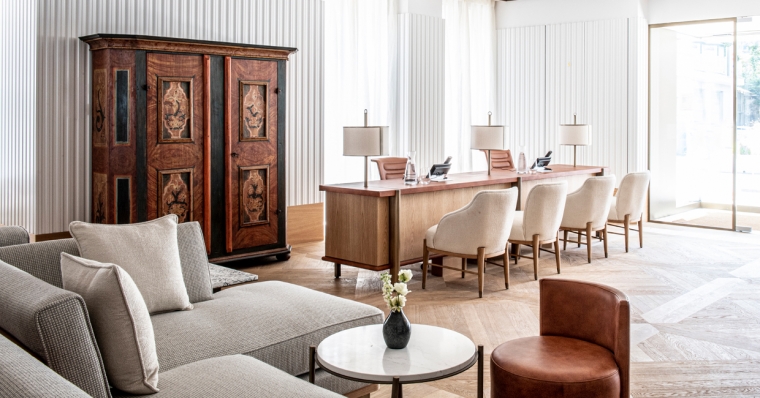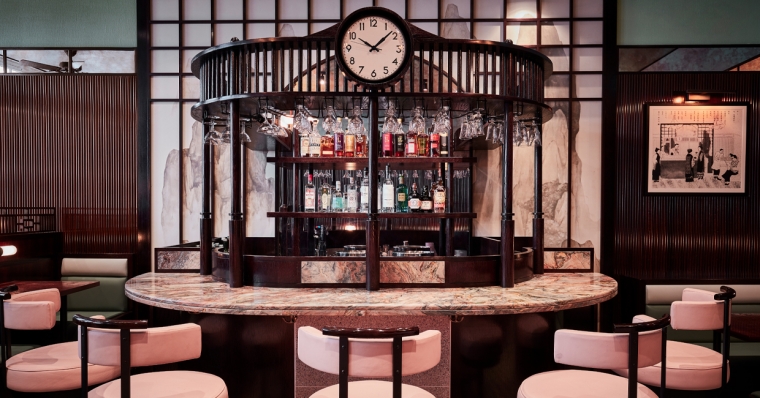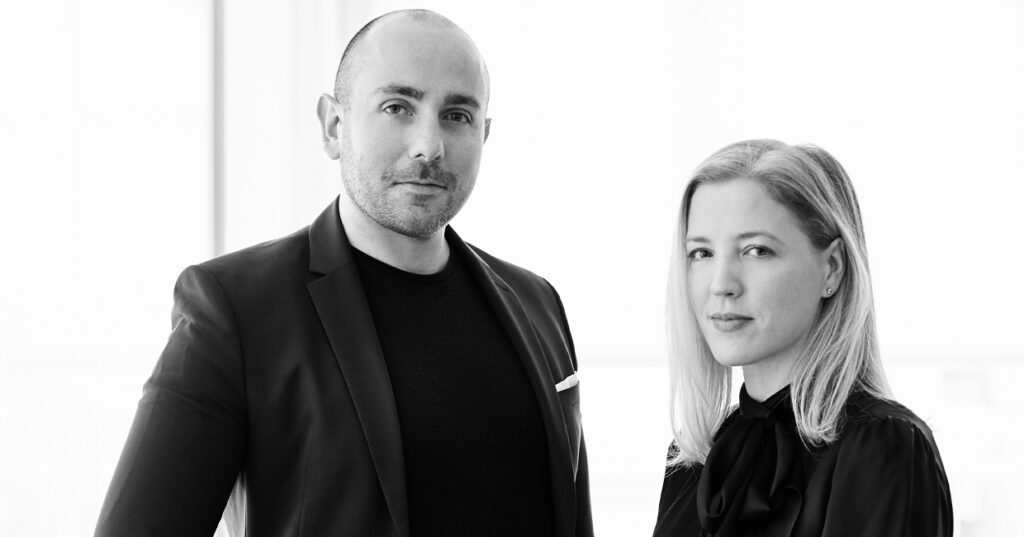BradyWilliams is a fully comprehensive bespoke interior design studio for both commercial and residential projects.
Designing the capital’s most sought-after properties, BradyWilliams creates timeless interiors with an emphasis on fine craftsmanship, acute detailing and seamless project management.
What three words would you use to describe BradyWilliams?
SB: Evocative, imaginative, experiential.
EW: Timeless, relaxed elegance, comfortable.
What does design mean to you?
SB: For me it’s a passion, being able to translate an abstract thought or idea into a built reality and problem solve through the entire process to then see guests enjoy a space you once envisioned only in your mind is truly special.

Describe your style?
SB: Within hospitality our work is theatrical, energetic and dynamic. Creating a sense of place is key to our hospitality projects, layered with materiality, texture, and detail with a key focus on lighting- what is a space without great lighting?
EW: Materiality and embracing the architecture is something we also take into our residential projects, but with a calmer approach to meet the client’s needs catering to how they like to live.
Where do you see hotel design in the future?
SB: I think smaller hotels with less keys, more intimate offerings, attracting people to experience an ultimate sense of escapism.
EW: We had already seen a rise in apartment hotels like our design for Hotel Alex on Lake Zurich, but I think we will see a return to people wanting service. We have missed and craved service, the human interaction is crucial, and this will impact the future of hotel design.
Do you believe simple design has become luxurious?
EW: Absolutely. The simplest of design using texture and clean lines can create the most indulgent and sumptuous interiors.
What particular trends have you noticed in hotel interior design?
SB: We think hotels have been influenced by what people love from the offering of Airbnb, and are translating it into their future hotel offering, thus creating the best of both worlds – guests want the feel of a private apartment stay, but with the luxuries that hospitality and service bring.
EW: Flexible multifunctional layouts are becoming key, allowing for long-stay guests and self-catering.
How do you think the influence of new technology affects the luxury traveller now and in the future?
SB: Technology is truly wonderful when used right, but overcomplicated technology leads to stressful and unpleasant hotel stays. Lighting, air conditioning and window treatments should all be able to be operated intuitively and not cause headaches when you are enjoying a hotel room. The other problem with technology is that it has led us all into the habit of expecting things instantly, but hopefully we are currently resetting as a result of lockdown, and the patience we have learned during this time will carry on into the future.
One example of the technology and design beautifully combined is the new Forme system by Yves Behar. It is a stylish mirror that transforms into a full home workout system , something that could easily be adapted into a seamless hotel guided gym workout either in a designated area or indeed in your hotel room.

How can design be used to manage the guest’s expectations of the hotel experience?
EW: A sense of atmosphere and experience is achieved through the finer details including clever lighting, choice of music and room fragrance. All of which combine to instantly set the tone of the experience that awaits a guest.
Turning to the topic of authenticity of experience, how do you approach each project?
SB: Each project needs a sense of place, when we designed Rockwell on Trafalgar, we were immediately inspired by the fact that the site was once an iconic pleasure garden of the 16th century and we reinterpreted this to fit the surroundings through the use of a more contemporary biophilic pattern printed on fabric.
EW: Similarly, for Hotel Alex we very much designed with an authentic sense of nature and location, paying homage to the extraordinary surrounding of the lake. This is reflected in our choice of materials through to the colour palette.
With Social media, especially Instagram, becoming an increasingly important marketing tool for hotels and F&B outlets. What are your thoughts on this, and do you take this into account when designing spaces?
SB: No, we just cannot design purely for Instagram! I honestly think some of the most atmospheric and best spaces to drink and dine in end up photographing the worst! Vice versa – those designed for just Instagram are often not comfortable to sit in or lack the atmosphere of an authentically designed space.
One of your recent projects Bob Bob Cite has an impressive lighting scheme which stands out from any other restaurant, what was your thoughts behind this?
SB: We collaborated closely with the owner, Leonid Shutov. Leonid was very clear he wanted an iconic lighting scheme unlike any other, so we created an entirely bespoke suite of decorative lighting manufactured by Dernier and Hamlyn. This was combined with architectural task lighting and the infamous ticker tape to reference both city traders and the iconic Soho ‘press for champagne’ button!
Many of your projects have a back story, can you tell us more about that?
SB: Storytelling and creating a sense of place is key for us throughout our projects, whether residential or hospitality. It is something that was instilled into our studio DNA during the early stages of our ongoing collaboration with Jeremy King in the development of restaurants like Fischer’s and Soutine and is something we carry through our work.
I had the same question be asked of me by two hoteliers, and that was If you had a limited budget to spend on design, what area would you focus on? i.e. guestrooms, public spaces, F&B and spa?
EW: Value engineering must be across the board. You cannot focus all efforts in one area, to create an overall impactful hotel all areas are equally important and thus the budget should be used effectively. Just cutting budget in one area will ruin the overall holistic vision of an offering. It’s also why it is imperative that a designer is employed for all stages of a project; the Quantity Surveyor does not know how best to value engineer from a design and experience perspective.
How important are public spaces in hotels? Are there ways in which you’ve used innovative design in these areas to facilitate innovative usage?
SB: Public areas are crucial for the socialising aspect of a hotel. Within Hotel Alex we designed the lobby, entrance and bar all as one space. This was key to creating a sense of home, a residential feel that felt welcoming. It also allowed for staff levels to be reduced; the receptionist checking you in could make you a martini at the bar and so it forms an intimate relationship between brand and guest.
Do you have any architects or designers you admire?
SB: Set designers greatly inspire me. Miriam Buether’s stage set for Wild Swans at the Young Vic in 2012 is something that I think will stick with me forever as a complete inspiration. Another would be Es Devlin, a set designer whose work I have always admired, also the Irish talents of interior designer Eileen Gray, and artist Mainie Jellett whose work still feels like a beautiful contemporary twist on Irish stained glass.
EW: I draw inspiration from both the Georgian and Edwardian architectural periods and styles. Also furniture designers such as Charlotte Perriand and her beautiful wall lights that we used in a recent project, to contemporaries such as Joseph Dirand and the confidence in Kelly Wearstler’s schemes

With so many hospitality designers in the industry, how does BradyWilliams stand out from the rest?
EW: Design is about creativity but it is also about rapport – we lead a team of charismatic designers that effuse design. We aim for all projects to feel different but have the BradyWilliams DNA while also understanding it is a service profession where everything you deliver is done with impeccable taste and professionalism – we are proud to have built a team of excellence at all levels.
What would be your dream hotel project?
SB: I have always been so inspired by Cuba I would love to create a new generation of design – something sympathetic not just import a London look to Cuba. Tokyo is a place I long to visit in the next year and who knows what that might lead to, or a coastal resort on the rugged west coast of Ireland!
EW: For me it would have to be a boutique hotel in a large French manor house or chateau.
Is there anything exciting that you’re working on which you can tell us about?
SB: We are pleased to say that this is a busy time for the studio. Our next opening on Hospitality will be Manzi’s in Soho for Corbin and King later this year. It’s fun and playful, a new destination in Soho that we have been working on now for 12 months, and with the year we have all had we are looking forward to having somewhere new to go to! We have three other Hospitality projects in the pipeline for later in the year which we cannot wait to realise.
EW: We are also working on a number of different residential projects from modern architecture through to period properties. Most notably a large Georgian property in Bristol and a duplex apartment in central London, both of which are resonant of our house style, but with their own twists.



